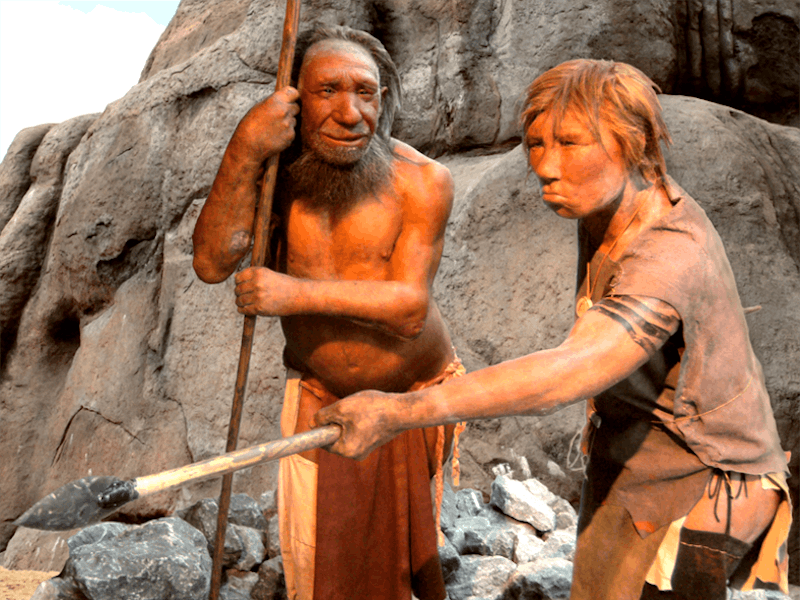In Southeast Asia, Ancient Humans Mated With at Least 4 Other Species
Two of the hominin species remain unnamed.

The ancient world was a lot like the world of Lord of the Rings, minus the magic. Different human-like beings roamed the Earth, sometimes interacting with Homo sapiens, also known as anatomically modern humans. It’s well established that these people, our ancestors, sometimes mated with these other members of the Homo genus. But according to a new study in Proceedings of the National Academy of Sciences, they may have mated with more species than scientists previously realized.
Researchers from the University of Adelaide report that it’s likely anatomically modern humans procreated with at least four other species of humans, thousands of years ago. These species included the relatively well-characterized Neanderthals and Denisovans — as well as two unnamed groups. So far, genetic traces of the latter mystery species have only been found in modern populations currently living in the maritime region of Southeast Asia, but scientists don’t know much about them.
“Island Southeast Asia was already a crowded place when what we call modern humans first reached the region just before 50,000 years ago,” says co-author João Teixeira, Ph.D. “At least three other archaic human groups appear to have occupied the area, and the ancestors of modern humans mixed with them before the archaic humans became extinct.”
Neanderthal DNA influences particular traits in humans.
Teixeira and co-author Alan Cooper, Ph.D., came to this conclusion by using previous studies to create a map of “mixing events.” These events are based on the amounts of archaic ancestry found in the genomes of living people.
The “mixing events” scientists know the most about are those between Homo neanderthalensis and Homo sapiens. Today, most Europeans and Asians have approximately two percent Neanderthal DNA.
Archeological and genomic evidence indicates that, as anatomically modern humans migrated out Africa, the met and interbred with Neanderthals in western Eurasia around 50,000 to 55,000 years ago. The fact that Neanderthal genes are still so ubiquitous suggests that the initial group of modern humans they met were small and remained intact long enough for Neanderthal DNA to mix through the founding population.
Yellow and red arrows indicate the presumed route of anatomically modern humans through Island Southeast Asia around 50,000 years ago.
East Asian populations carry about 12 to 20 percent more Neanderthal DNA than Europeans, so scientists reason that there was at least another “wave” of genetic mixing as anatomically modern humans continued their journey east. It’s also been established that in eastern Eurasia, modern humans interbred with the Denisovans, another group of ancient humans.
While we know less about Denisovans — until recently the only known fossil record of this group was limited to a pinkie bone found in southern Siberia — some of their genes are present in the DNA of living East Asian individuals, South Asians, and Aboriginal people in Australia and Papua New Guinea. Because East Asians have a second set of Denisovan genomes that are not found in South Asians and Papuans, scientists to believe Denisovan interbreeding with Homo sapiens happened in at least two independent episodes as well.
In the new study, Teixeira and Cooper cite evidence of interbreeding with another extinct hominin (EH) they simply call “EH1.” While some scientists have proposed that EH1 might have been Denisovan, Teixeira and Cooper argue it is “so genetically divergent that it is equidistant to both Neanderthals and Denisovans, and probably represents an entirely new hominin group.” The working theory is that the anatomically modern human ancestor of all all Asian and Australo-Papuan populations interbred with EH1, resulting in a shared genome.
Meanwhile, the presence of another unknown extinct hominin, EH2, can be seen in the genomes of individuals currently living near Liang Bua Cave in Flores, Indonesia. Its unique genomic signature appears to be as divergent from the genomes of modern-day humans as it is to the genomes of the Neanderthals and Denisovans. It’s also currently unclear how it’s related to Homo floresiensis, a species of extinct humans whose remains have also been found in Flores.
What is strikingly clear is that Southeast Asia was a hotbed of ancient human activity that scientists are still striving to understand. This region was clearly occupied by several archaic human groups that likely lived in relative isolation from one another for hundreds of years. These ancient humans left unique marks on the genes of their descendants, who still live in this area today.
Whether or not their interactions with modern humans were positive ones remains to be seen. Teixeira notes that “the timing also makes it look like the arrival of modern humans was followed quickly by the demise of the archaic human groups in each area.”
Abstract:
The dispersal of anatomically modern human populations out of Africa and across much of the rest of the world around 55 to 50 thousand years before present (ka) is recorded genetically by the multiple hominin groups they met and interbred with along the way, including the Neandertals and Denisovans. The signatures of these introgression events remain preserved in the genomes of modern-day populations, and provide a powerful record of the sequence and timing of these early migrations, with Asia proving a particularly complex area. At least 3 different hominin groups appear to have been involved in Asia, of which only the Denisovans are currently known. Several interbreeding events are inferred to have taken place east of Wallace’s Line, consistent with archaeological evidence of widespread and early hominin presence in the area. However, archaeological and fossil evidence indicates archaic hominins had not spread as far as the Sahul continent (New Guinea, Australia, and Tasmania), where recent genetic evidence remains enigmatic.